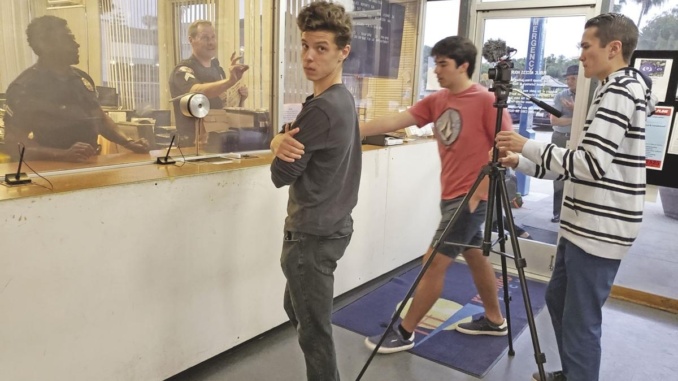
By Madeleine Powell
Editor-in-Chief
Directed by Mira Costa junior Ethan Nahlinder, the short film “A Night in Jail” powerfully depicts a compelling story about the dangers of teen drug abuse.
Screened on Aug. 18 in the Hermosa Beach 2nd Story Theatre, “A Night in Jail” is based on the novella of the same name by Hermosa Beach resident Heidi Swan. Inspired by true events, Swan wrote the story drawing from the experiences of her brother, Kirk Anderson, whose experiences with addiction and mental illness make up the basis of both the book and film.
“A Night in Jail” tells the story of a high school student Danny, played by junior Travers Tobis, who is arrested for smoking marijuana and forced to spend a night in his local jail. His cellmate, a homeless and mentally ill man named Captain, played by Charlie Scola, showcases to Danny the dangers that this seemingly harmless choice to smoke can have on his life. At the film’s screening, Swan and Nahlinder explained that one of the story’s primary objectives is to showcase the connection between marijauna use and mental illness, which is often overlooked and underestimated.
The film’s cinematography only allows for the story to grow even more, as the symbolism behind shots throughout the film illustrated the power struggle between Captain and Danny. At the beginning, the camera reveals Danny through the legs of Captain, showing Captain as a looming figure over Danny’s life. As the film progresses, however, these roles shift, showing Danny’s struggles to take control back of his life and his future. These details, which were highlighted by Nahlinder at the film’s screening, reveal the careful thought that the crew poured into every shot of the film.
“A Night in Jail” is especially effective in conveying its messages concerning teens. Nahlinder is able to share his unique perspective as a teen filmmaker with a film that is first and foremost about teens and the effects of the decisions they make. His choice to educate others through his film about an issue that can impact both him and his peers makes the film remarkably more meaningful to audience members as they recognize its relevance, both in his and their own lives.
Tobis’ acting is one of the film’s great strengths and another reason why the film resonates so deeply with its audience. The adaption of Swan’s novel into the medium of film only serves to further illustrate the negative effects marijuana abuse can have on people’s lives, which made possible through Tobis’ talent in conveying Danny’s emotions. His ability to showcase his own inner turmoil makes it difficult at times for viewers to remember that they are watching a film.
“A Night in Jail” similarly boasts impeccable set design through its jail cell, where Danny and Captain spend their night. The cell appears to be completely authentic, although it was constructed inside of Swan’s basement, showing the attention-to-detail and care with which this project was treated, as well as its dedication to preserving the novella’s subject matter and creating a realistic viewing experience for audience members.
Calling the film impressive for a teen filmmaker would diminish Nahlinder’s accomplishments; his work cannot be examined solely through the lens of a high school student. As a filmmaker, he has taken a poignant work and further strengthened its emotional resonance in a way that can only be described as professional.
For more information on “A Night in Jail,” both the film and novella, visit anightinjail.com.


Leave a Reply